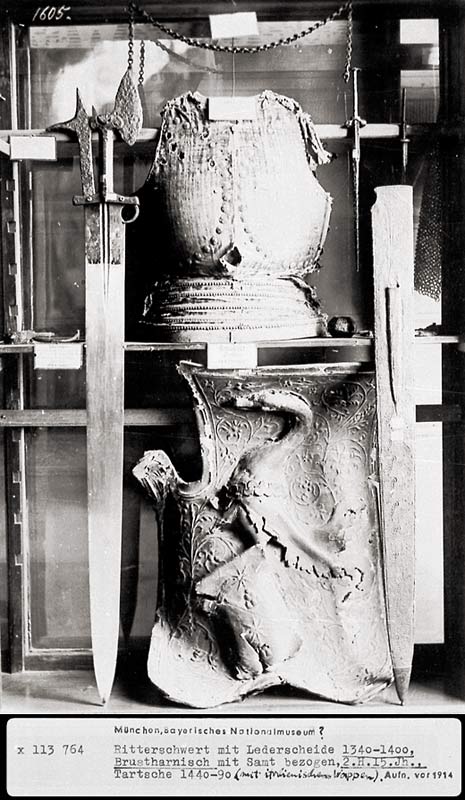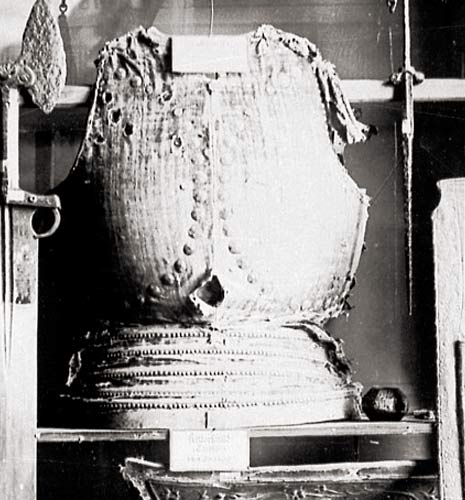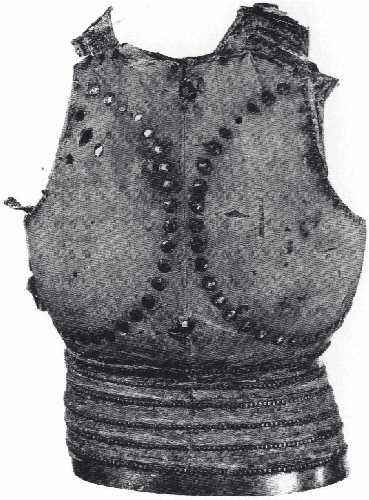| Author |
Message |
Nathan Robinson
myArmoury Admin


|
 Posted: Thu 24 Aug, 2006 5:33 am Post subject: Covered Armour Posted: Thu 24 Aug, 2006 5:33 am Post subject: Covered Armour |
 |
|
The photo attached is from The Bayerisches Nationalmuseum. It shows many wonderful things including a few unusual items. Take note of the sword to the left with the circular finger ring and its scabbard to the right with what appears to be a place for by-knives and a cut-out for the finger-ring. Speaking the sword, it's a wondeful example of form similar to Oakeshott's later blade types with the two short fullers. The axe/polearm behind the sword hilt is also interesting as is the shield.
But what I am really curious about is the armour. It appears to be covered in fabric and I was hoping to get a discussion going about it. I'm especially eager to read thoughts as to exactly what it is thought to be.
Thank you.
 Attachment: 78.65 KB Attachment: 78.65 KB

Objects from The Bayerisches Nationalmuseum
 Attachment: 44.13 KB Attachment: 44.13 KB

From The Bayerisches Nationalmuseum (close-up)
.:. Visit my Collection Gallery :: View my Reading List :: View my Wish List :: See Pages I Like :: Find me on Facebook .:.
|
|
    |
 |
Gordon Clark

|
 Posted: Thu 24 Aug, 2006 6:07 am Post subject: Posted: Thu 24 Aug, 2006 6:07 am Post subject: |
 |
|
I am not much of an expert, but it seems to me that many period illustrations lack "white" armour on the torso, and instead have either covered breastplates or brigandines. For example, this one looks like a mix of brigs and covered breastplates to me:
Also included is another actual example of a 14th century Italian velvet covered breastplate I found in a quick search. (pic from http://houseasgard.com/fighting.php )
Gordon
 Attachment: 34.37 KB Attachment: 34.37 KB

 Attachment: 47.08 KB Attachment: 47.08 KB

Last edited by Gordon Clark on Thu 24 Aug, 2006 8:20 am; edited 1 time in total
|
|
  |
 |
|
Allen W
|
 Posted: Thu 24 Aug, 2006 6:48 am Post subject: Posted: Thu 24 Aug, 2006 6:48 am Post subject: |
 |
|
|
I was of the impression that these covered breast plates were typical of the early 15th cent., often being of two or more parts. I can't recall a source for any of this but the the globose nature of the the breast was standard in the late 14th and early 15th centuries. The Axe/polearm you mentioned I don't think is a polearm at all but rather a hurlbat. That is a small, all metal throwing axe with multiple points. The deep relief on the shield makes me suspect built up plaster on the underlying wood though i've never before heard of such and don't know what such plaster might weigh. I do expect the wood to be ply and believe that it would delaminate with such deep carving but lack any practical experience on the subject.
|
|
  |
 |
Randall Moffett

|
 Posted: Thu 24 Aug, 2006 6:57 am Post subject: Posted: Thu 24 Aug, 2006 6:57 am Post subject: |
 |
|
Nathan,
Fabric covered breastplates are very common in the 14th to 15th. I assume it evolved with the Coat of Plates (or 'plates') and as the plates grew to just be one breastplate the farbic remained. In part this may be that it made the faulds connection easy still. I have some pictures of some in museums. There is also the corrazza in the MET that is a few large plates combined all fabric covered. In part art work is tricky as you have fabirc armour as well as items of fabric worn over armour and you have fabric covered armour to deal with to figure out which one they wear. I assume that they likely were easier and cheaper so likely continued on parallel to full suits for lesser gentry and MAA.
RPM
|
|
  |
 |
|
Wolfgang Armbruster
|
 Posted: Thu 24 Aug, 2006 7:37 am Post subject: Posted: Thu 24 Aug, 2006 7:37 am Post subject: |
 |
|
The description says "breastplate covered with velvet, second part of the 15th century". Seems to be not too uncommon for that time. Hope this helps a bit 
|
|
  |
 |
Gordon Clark

|
 Posted: Thu 24 Aug, 2006 8:22 am Post subject: Posted: Thu 24 Aug, 2006 8:22 am Post subject: |
 |
|
| Allen W wrote: | | I was of the impression that these covered breast plates were typical of the early 15th cent., often being of two or more parts. I can't recall a source for any of this but the the globose nature of the the breast was standard in the late 14th and early 15th centuries. The Axe/polearm you mentioned I don't think is a polearm at all but rather a hurlbat. That is a small, all metal throwing axe with multiple points. The deep relief on the shield makes me suspect built up plaster on the underlying wood though i've never before heard of such and don't know what such plaster might weigh. I do expect the wood to be ply and believe that it would delaminate with such deep carving but lack any practical experience on the subject. |
The description at the houseasgard site says "late 14th century" - I agree, the globular look I think of as late 14th, early 15th.
Gordon
|
|
  |
 |
|
Risto Rautiainen
|
 Posted: Thu 24 Aug, 2006 8:45 am Post subject: Posted: Thu 24 Aug, 2006 8:45 am Post subject: |
 |
|
|
Aren't those pics of the same breastplate? I mean look at the "holes" in the covering on the left. They're identical on both breastplates.
|
|
  |
 |
Gordon Clark

|
 Posted: Thu 24 Aug, 2006 9:13 am Post subject: Posted: Thu 24 Aug, 2006 9:13 am Post subject: |
 |
|
| Risto Rautiainen wrote: | | Aren't those pics of the same breastplate? I mean look at the "holes" in the covering on the left. They're identical on both breastplates. |
They are very similar, but the lower part (faulds?) seems much more bell shaped on Nathan's pic, and narrower on the one I posted. Could that just be an angle, or perhaps the way the piece was arranged when shot?
You are right though, the holes are the same. I guess it must be the same piece.
Gordon
|
|
  |
 |
|
Peter Johnsson
Industry Professional
|
 Posted: Thu 24 Aug, 2006 10:06 am Post subject: Posted: Thu 24 Aug, 2006 10:06 am Post subject: |
 |
|
Thanks for posting that Nathan.
I really like the baselard-sword.
Have not seen that one.
I was only aware of the type from one item at Herman Historica, but that one lacked grip scales.
really good to see a complete example.
I just have to make one of those some time. Next year solingen project perhaps?
 Attachment: 7.46 KB Attachment: 7.46 KB

 Attachment: 18.91 KB Attachment: 18.91 KB

|
|
   |
 |
Nathan Robinson
myArmoury Admin


|
 Posted: Thu 24 Aug, 2006 11:58 am Post subject: Posted: Thu 24 Aug, 2006 11:58 am Post subject: |
 |
|
| Wolfgang Armbruster wrote: | The description says "breastplate covered with velvet, second part of the 15th century". Seems to be not too uncommon for that time. Hope this helps a bit  |
Thank you for the translation. This is exactly what I was hoping to know. I'd like to do some research on the velvet trade and production methods for this early time period. I have only read of such for the Renaissance (late 16th century onwards) but this earlier period is not discussed in my sources. I can only guess as to the changes that might have happened within the 100 or so years difference.
Thank you guys for noting that identical hole placement and nailing that the breastplate in the photo I posted is the very same as te other.
.:. Visit my Collection Gallery :: View my Reading List :: View my Wish List :: See Pages I Like :: Find me on Facebook .:.
|
|
    |
 |
Nathan Robinson
myArmoury Admin


|
 Posted: Thu 24 Aug, 2006 12:02 pm Post subject: Posted: Thu 24 Aug, 2006 12:02 pm Post subject: |
 |
|
| Peter Johnsson wrote: | Thanks for posting that Nathan.
I really like the baselard-sword.
Have not seen that one.
I was only aware of the type from one item at Herman Historica, but that one lacked grip scales.
really good to see a complete example.
I just have to make one of those some time. Next year solingen project perhaps? |
I Peter-
While posting this, I actually thought of you and wondered if you'd take note of the sword. I have the same auction photo saved on my system (sans description, unfortunately), and this is one of the only similar swords to it that I've seen. It's pretty unique.
.:. Visit my Collection Gallery :: View my Reading List :: View my Wish List :: See Pages I Like :: Find me on Facebook .:.
|
|
    |
 |
Torsten F.H. Wilke

Location: Irvine Spectrum, CA Joined: 01 Jul 2006
Posts: 250
|
 Posted: Thu 24 Aug, 2006 6:37 pm Post subject: Posted: Thu 24 Aug, 2006 6:37 pm Post subject: |
 |
|
|
Did anyone notice the relative size of the two? The breastplate seems like it was made for a toddler!!! OK, so thats an exageration, but none-the-less... Or, is that sword a three-hander?
|
|
  |
 |
|
Jonathon Janusz
|
 Posted: Thu 24 Aug, 2006 6:57 pm Post subject: Posted: Thu 24 Aug, 2006 6:57 pm Post subject: |
 |
|
|
This is a pretty piece of armour. I remember seeing a color photograph of it once. . . I want to say it is in the Wisby book, but mine is currently on loan, so I can't check. Red velvet with brass (gold plated?) rivets if memory serves. . .
|
|
  |
 |
Jean Thibodeau

|
 Posted: Thu 24 Aug, 2006 7:12 pm Post subject: Posted: Thu 24 Aug, 2006 7:12 pm Post subject: |
 |
|
Don't know if this helps but Valentine armouries makes a velvet covered breast plate and maybe they could tell us about any sources they used as inspiration.
http://www.varmouries.com/tran_06.html
Oh, that sword looks interesting and I agree it is either very large or the breast plate is very small.
The only other possibility is a perspective visual illusion caused by the sword being closer to the camera or the breast plate further away than initially assumed.
You can easily give up your freedom. You have to fight hard to get it back!
|
|
  |
 |
|
Al Muckart
|
 Posted: Thu 24 Aug, 2006 8:23 pm Post subject: Posted: Thu 24 Aug, 2006 8:23 pm Post subject: |
 |
|
| Torsten F.H. Wilke wrote: | | Did anyone notice the relative size of the two? The breastplate seems like it was made for a toddler!!! OK, so thats an exageration, but none-the-less... Or, is that sword a three-hander? |
It's difficult not knowing the scale of the wearer that was made for, but I imagine it's not so much that the breastplate is tiny as that the proportions on it aren't what we are used to seeing.
The pervading aesthetic of that period was for quite a globose chest and a comparatively high waistline. Those faulds probably start quite a bit above the natural waist of the wearer. When it's all scrunched down like that it makes it look very wide and short, when in realtity on a wearer it won't be.
I don't think the breastplate area on that is much bigger than the main plates in a lungplate brigandine.
--
Al.
http://wherearetheelves.net
|
|
   |
 |
Randall Moffett

|
 Posted: Thu 24 Aug, 2006 10:36 pm Post subject: Posted: Thu 24 Aug, 2006 10:36 pm Post subject: |
 |
|
I wonder if the date placed on it is accurate and has not changed. I have abook with an identical breastplate and it is late 14th. Usually by the late 15th the faulds are attached to themselves whether covered or not. In this it is clearly attached to the fabric. Also looks like the pics are at least sixty to seventy years old so I guess alot has happened since then.
RPM
|
|
  |
 |
Chuck Russell

|
 Posted: Fri 25 Aug, 2006 4:39 am Post subject: Posted: Fri 25 Aug, 2006 4:39 am Post subject: |
 |
|
|
globose breastplates stop shortly after teh rib cage area. thats tehy way they were made. this is a good representation of a late 14thc breastplate. its not late 15th cause the style is wrong. almost all bb were 2 piece by then. also in 15thc there are laws about covereing armour with fabric to hide shotty workmanship. the bb at the met is sorta a reconstruction and its made wrong at that. the faulds are done incorrectly. this one (nathan's picture) is how theyshould look. they move very nicely
|
|
    |
 |
Chuck Russell

|
 Posted: Fri 25 Aug, 2006 4:44 am Post subject: Posted: Fri 25 Aug, 2006 4:44 am Post subject: |
 |
|
|
also as to the size of armour. a lot of what we have left is childrens armour. of nobles, princes etc. this is due to adult armour being used and abused and reused in the next decades.
|
|
    |
 |
Hisham Gaballa

|
 Posted: Fri 25 Aug, 2006 5:03 am Post subject: Posted: Fri 25 Aug, 2006 5:03 am Post subject: |
 |
|
| Chuck Russell wrote: | | globose breastplates stop shortly after teh rib cage area. thats tehy way they were made. this is a good representation of a late 14thc breastplate. its not late 15th cause the style is wrong. almost all bb were 2 piece by then. also in 15thc there are laws about covereing armour with fabric to hide shotty workmanship. the bb at the met is sorta a reconstruction and its made wrong at that. the faulds are done incorrectly. this one (nathan's picture) is how theyshould look. they move very nicely |
I can't see the picture Chuck. 
|
|
  |
 |
Christian Henry Tobler

Location: Oxford, CT Joined: 25 Aug 2003
Posts: 704
|
 Posted: Fri 25 Aug, 2006 6:56 am Post subject: Posted: Fri 25 Aug, 2006 6:56 am Post subject: |
 |
|
| Jean Thibodeau wrote: | | Don't know if this helps but Valentine armouries makes a velvet covered breast plate and maybe they could tell us about any sources they used as inspiration. |
Hi Jean -
The Valentine piece (and other modern armourers replicate it as well) is based on the 14th century armour display at the Metropolitan Museum of Art in New York. Unfortunately, it is not historic - Dr. Bashford Dean assembled the speculative cuirass from various bits and pieces, some deriving, if memory serves, from the Chalcis Hoard.
As cool as this piece looks, I rather wish modern armourers would stop using it as a model as the piece a) isn't historic and b) has some practical design issues. There are certainly examples of real covered breastplates, both in museums and iconographic sources, that can be replicated instead.
All the best,
Christian
Christian Henry Tobler
Order of Selohaar
Freelance Academy Press: Books on Western Martial Arts and Historical Swordsmanship
Author, In Saint George's Name: An Anthology of Medieval German Fighting Arts
|
|
    |
 |
|
|

